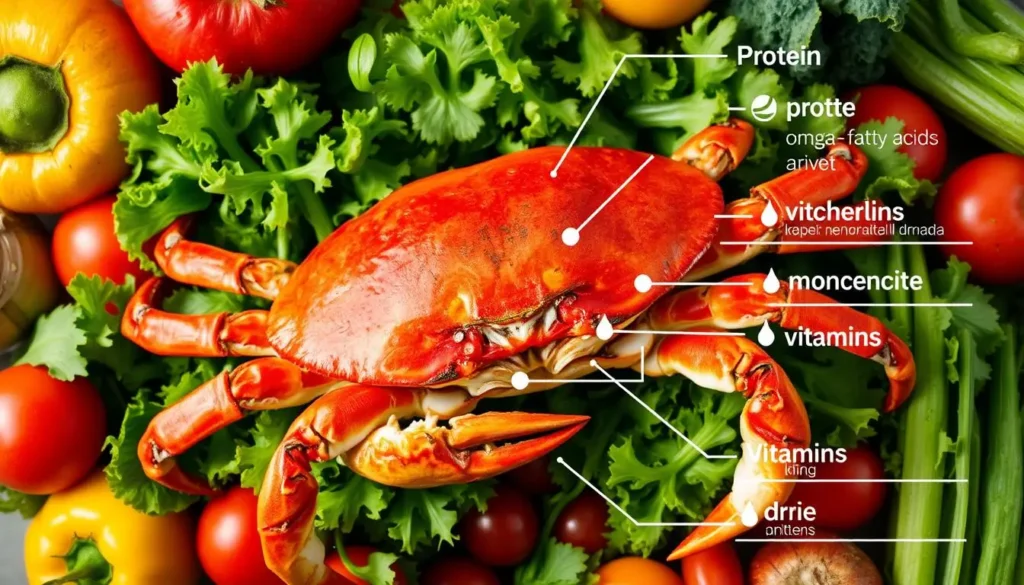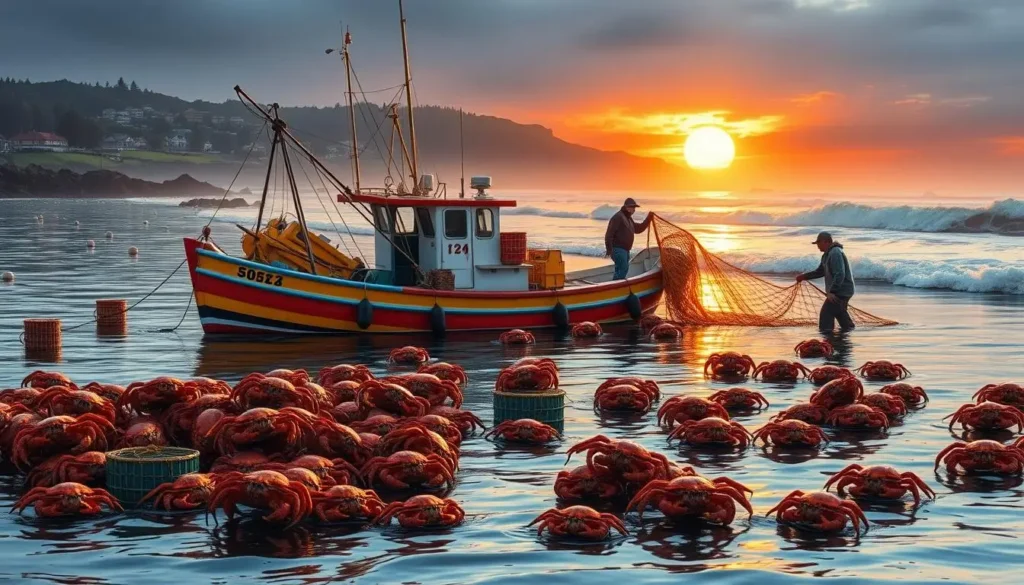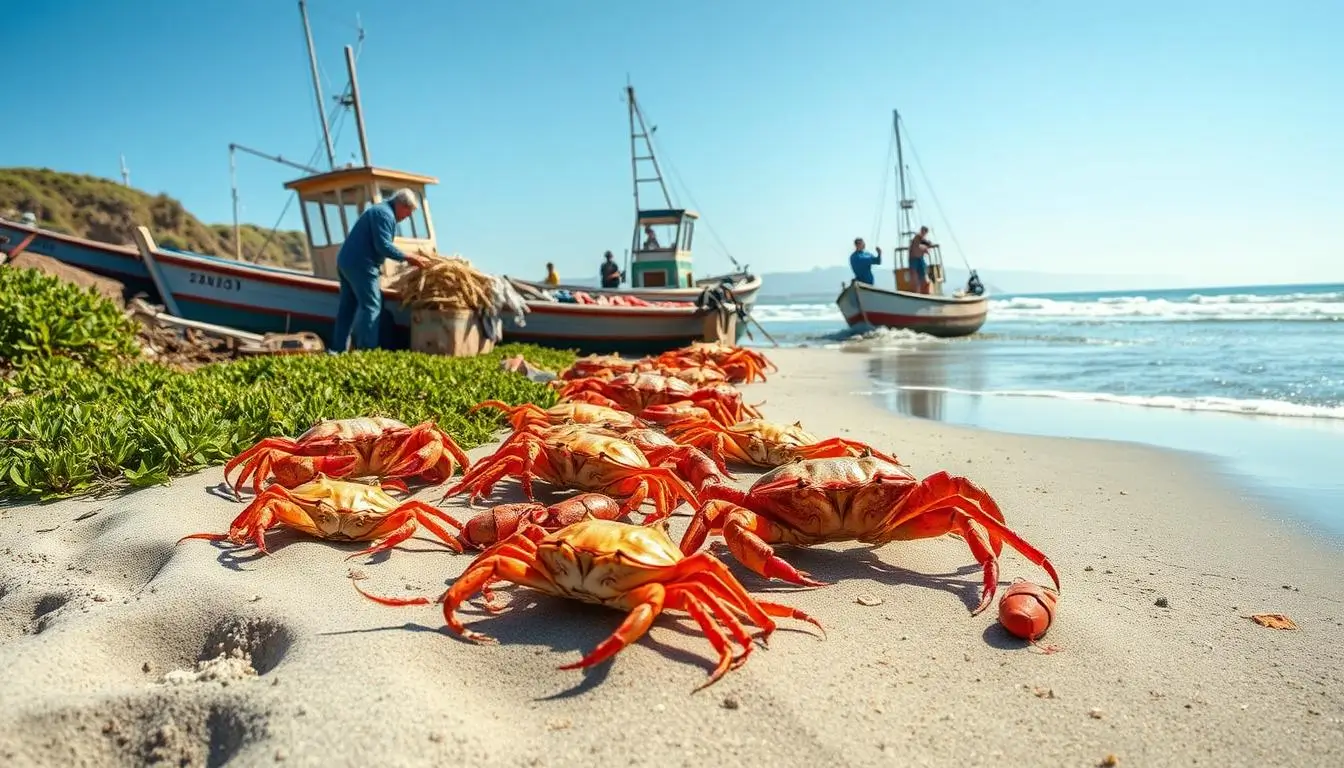Welcome to the ultimate guide to the Dungeness crab season. Here, you’ll learn about Pacific Northwest seafood and tasty crab recipes. This season is perfect for enjoying the freshest catches and exploring the rich flavors of Dungeness crab.
In this guide, we’ll explore the world of Dungeness crab. You’ll learn about its unique traits and cultural importance. Whether you love seafood or want to try something new, this guide has everything you need to know about the Dungeness crab season.

Get ready to dive into the world of Dungeness crab. We’ll show you the best ways to enjoy this Pacific Northwest seafood delicacy. You’ll find mouth-watering crab recipes and expert tips for making the most of the season.
Key Takeaways
- The Dungeness crab season offers a unique opportunity to enjoy fresh Pacific Northwest seafood
- Delicious crab recipes can be explored during this time, from traditional to modern creations
- Understanding the Dungeness crab’s characteristics is key to appreciating its flavor and texture
- The season is a great time to learn about sustainable harvesting practices and conservation efforts
- With the right guide, you can make the most of the Dungeness crab season and enjoy this seafood delicacy to the fullest
What Makes Dungeness Crab Special
Dungeness crab is a seafood favorite known for its great taste and health benefits. It’s loved for its unique flavor and texture. This makes it a joy to eat.
Dungeness crab is also very nutritious. It’s full of protein, omega-3 fatty acids, and vitamins and minerals. It’s low in calories and fat, perfect for those watching their diet.
Distinctive Taste Profile
The taste of Dungeness crab is sweet and savory with a hint of salt. This flavor comes from its diet and where it lives.
Nutritional Benefits
Some key benefits of Dungeness crab include:
- High protein content
- Rich in omega-3 fatty acids
- Good source of vitamins and minerals, such as vitamin B12 and selenium
- Low in calories and saturated fat
Size and Meat Content
Dungeness crab is big and has a lot of meat. A crab can weigh 1-4 pounds, with most of that being meat. This makes it a great value for seafood lovers.

In summary, Dungeness crab is special because of its nutrition, taste, and size. It’s a must-try for seafood fans. It offers many health benefits and is delicious.
| Nutrient | Amount per 3 oz serving |
|---|---|
| Protein | 20g |
| Omega-3 fatty acids | 0.5g |
| Vitamin B12 | 10mcg |
| Selenium | 45mcg |
Understanding the Dungeness Crab Season
The Dungeness crab season is a big deal in the seafood industry. It draws in crab lovers and commercial fishermen. The season usually runs from November to June, with the busiest months from December to April. During this time, fishermen use traps and nets to catch Dungeness crabs.
The crab season is managed well to keep the fishery healthy. Rules are set to protect the crabs and their homes. This helps the environment and supports the local seafood industry. It also means people can enjoy fresh, tasty crab.

- Peak season: December to April
- Fishing methods: Traps and nets
- Regulations: In place to protect the crab population and habitat
These efforts make the Dungeness crab fishing season a success. They help the local seafood industry and give crab fans a special experience.
| Month | Crab Season |
|---|---|
| November | Start of the season |
| December | Peak season begins |
| April | Peak season ends |
| June | End of the season |
The Rich History of Dungeness Crabbing
Dungeness crab history is rich and fascinating. Native American tribes in the Pacific Northwest have been catching crab for food and ceremonies for thousands of years. The Dungeness crab was key to their fishing traditions, providing vital nutrition and income.
When commercial fishing started in the late 19th century, new ways to catch Dungeness crab were introduced. This led to a bigger industry. Today, the focus is on keeping the fishery sustainable and supporting the community.
Native American Heritage
The Native American heritage in Dungeness crab fishing is still honored today. Many tribes still fish for crab using old ways. The crab is not just food but also holds deep cultural and spiritual value.
Commercial Fishing Development
Commercial fishing for Dungeness crab has greatly impacted the industry. Many fishermen depend on crab for their income. This has led to innovation, making fishing more sustainable and efficient.
Modern Industry Evolution
Now, the Dungeness crab industry is modern and focused on sustainability. It follows strict rules to keep the fishery healthy for the future. This blend of old traditions, commercial growth, and new practices has made the industry strong and unique.
| Year | Dungeness Crab Harvest | Value |
|---|---|---|
| 2010 | 30 million pounds | $100 million |
| 2015 | 40 million pounds | $150 million |
| 2020 | 50 million pounds | $200 million |
Best Locations for Dungeness Crab
The Pacific Northwest is a paradise for seafood lovers. Its rugged coastlines and scenic bays are perfect for finding fresh Dungeness crab. Places like San Francisco’s Fisherman’s Wharf, Seattle’s Pike Place Market, and Portland’s seafood spots are top choices.
For those who want to catch Dungeness crab themselves, there are great spots to try. These places offer a chance to feel the excitement of crabbing and enjoy a fresh catch. Here are some top spots:
- Coos Bay, Oregon: Known for its rich Dungeness crab population, Coos Bay is a favorite among crabbers.
- Bodega Bay, California: This bay is a crab haven with beautiful views of the Pacific.
- Puget Sound, Washington: Its calm waters and rich marine life make it perfect for crab fishing.
Whether you’re an experienced crabber or new to it, the Pacific Northwest has many options. Its natural beauty and fresh seafood make it a must-see for Dungeness crab fans.
So, why not plan a trip to the Pacific Northwest for Dungeness crab fishing? It’s a mix of stunning nature and tasty seafood that will leave you eager for more.
| Location | Best Time to Visit | Popular Activities |
|---|---|---|
| Coos Bay, Oregon | December to April | Crabbing, fishing, hiking |
| Bodega Bay, California | November to March | Crabbing, whale watching, kayaking |
| Puget Sound, Washington | October to February | Crabbing, fishing, boating |
How to Select the Perfect Dungeness Crab
Choosing the perfect Dungeness crab involves several key factors. You want to ensure you get the best fresh seafood experience. Look for signs of freshness, size, and whether to pick a male or female crab. A sweet smell and a firm, heavy body are signs of crab quality.
Here are some guidelines for selecting Dungeness crabs:
- Choose crabs with a vibrant color and a lively appearance.
- Check the crab’s body for any signs of damage or soft spots.
- Opt for crabs that are heavy for their size, as they have more meat.
Larger crabs usually have more meat, making them a favorite for a hearty fresh seafood meal. But, size also depends on personal taste and how you plan to use the crab. It’s crucial to focus on crab quality and freshness when selecting.
The secret to picking the perfect Dungeness crab is to prioritize fresh seafood and crab quality. By considering these factors and following the guidelines, you’ll enjoy a delicious Dungeness crab experience.
| Crab Size | Meat Content | Recommended Use |
|---|---|---|
| Small (1-2 pounds) | Less meat, but sweeter flavor | Ideal for soups, stews, or salads |
| Medium (2-3 pounds) | More meat, balanced flavor | Suitable for steaming, boiling, or grilling |
| Large (3-4 pounds) | Most meat, rich flavor | Perfect for special occasions or as a centerpiece |
Essential Tools for Crab Preparation
When it comes to crab preparation, the right tools are key. With the right seafood tools and kitchen essentials, you’ll have a blast. You’ll need a few important items to start, like:
A big pot for steaming or boiling, a crab cracker, and a seafood fork. Also, kitchen shears and a cutting board are useful for cleaning and preparing the crab.
- Crab cracker: for cracking open the shells and accessing the meat
- Seafood fork: for picking out the meat from the shells
- Large pot: for steaming or boiling the crab
- Kitchen shears: for cutting and preparing the crab
- Cutting board: for cleaning and preparing the crab
Having these tools will make crab preparation easy. You’ll enjoy your delicious Dungeness crab without any hassle. With the right seafood tools and kitchen essentials, you’ll become a crab prep pro.
Step-by-Step Cooking Methods
There are many ways to cook Dungeness crab, each with its own benefits. For beginners, Dungeness crab recipes are a perfect starting point. Steaming is a favorite because it keeps the crab’s flavor and texture intact.
Boiling is another method, great for cooking several crabs at once. It’s common in commercial cooking but works well at home too. Grilling adds a smoky taste, making it a fun way to cook Dungeness crab. Here’s how to begin:
Steaming Technique
Steaming is excellent for Dungeness crab. It keeps the meat tender and flavorful. To steam, place the crab in a steamer basket over boiling water. Cover it and steam for 10-15 minutes.
Boiling Instructions
Boiling is a popular choice for cooking Dungeness crab. Fill a big pot with water, add salt and lemon juice, and boil. Then, add the crab, cover, and boil for 10-15 minutes.
Grilling Options
Grilling adds a smoky flavor to Dungeness crab. Preheat your grill to medium-high, brush the crab with oil, and season. Grill for 5-7 minutes on each side.
By following these steps and choosing the right cooking method, you can make tasty Dungeness crab dishes. Whether you’re experienced or new to seafood cooking, Dungeness crab recipes are a great way to explore.
Traditional Pacific Northwest Crab Recipes
The Pacific Northwest is famous for its fresh seafood. Dungeness crab is a key part of the region’s seafood cuisine. Traditional Pacific Northwest recipes often use Dungeness crab, showing off its rich taste and flexibility.
Popular Dungeness crab recipes include crab cakes, crab and corn chowder, and steamed crab with melted butter. These dishes are tasty and highlight Dungeness crab’s unique qualities.
- Crab cakes with a twist, featuring fresh herbs and spices
- Crab and corn chowder, a hearty and comforting soup
- Steamed crab with melted butter, a simple yet elegant dish
These traditional Pacific Northwest recipes will quickly become favorites. They’re a great way to enjoy the unique flavors of the region’s seafood cuisine.
Sustainable Harvesting Practices
The Dungeness crab fishery is managed carefully to last long. Rules are set to protect crabs and their homes. This way, we can enjoy Dungeness crab for many years.
Thinking about the environment is important too. Efforts are made to lessen harm to the ecosystem. This includes reducing bycatch and protecting habitats. Some key actions are:
- Setting catch limits to avoid overfishing
- Creating closed areas for crab habitats to recover
- Limiting fishing gear to reduce damage
These steps help keep the Dungeness crab fishery healthy. By fishing sustainably, we make sure Dungeness crab stays a valuable resource for the future.
Current Regulations
Rules are key to keeping the Dungeness crab fishery sustainable. Today, we have:
| Regulation | Purpose |
|---|---|
| Catch limits | To prevent overfishing and allow crab populations to replenish |
| Closed areas | To protect habitats and prevent habitat destruction |
| Gear restrictions | To minimize bycatch and habitat damage |
Conservation Efforts
Conservation is vital for the Dungeness crab fishery’s future. Important conservation actions include:
Tracking crab populations and habitats through research. Also, educating people about caring for the environment and fishing responsibly.
Storing and Preserving Your Catch
Keeping Dungeness crab fresh and safe is key. You can store it in a cool, moist place like a fridge or cooler with ice. This stops bacteria from growing and keeps the crab fresh longer.
Freezing is also a good choice for longer storage. It keeps the crab’s taste and texture good. But, you must follow food safety rules to avoid contamination. Important steps for storing crab include:
- Keeping the crab at a consistent refrigerated temperature below 40°F (4°C)
- Freezing the crab at 0°F (-18°C) or below
- Using airtight containers or freezer bags to prevent moisture and other flavors from affecting the crab
- Labeling and dating the stored crab to ensure it’s used within a safe time frame
By following these steps, you can enjoy your Dungeness crab longer. Always remember to keep food safety in mind to avoid illness.
It’s also important to handle the crab gently. This prevents injury and stress, which can lower the meat’s quality. With the right handling and storage, you can enjoy the crab’s flavor and texture while staying safe.
| Storage Method | Temperature | Shelf Life |
|---|---|---|
| Fresh Storage | Below 40°F (4°C) | 1-3 days |
| Freezing | 0°F (-18°C) or below | 6-12 months |
Pairing Suggestions and Serving Ideas
Enjoying Dungeness crab is even better with the right seafood pairing. Try it with melted butter, lemon juice, and garlic for a classic taste. Or, mix it up with avocado, bacon, or herbs like parsley or dill for something new.
Looking to try something different in the kitchen? There are many crab recipes to try. From simple steamed crab to crab cakes and seafood pasta, there’s a lot to explore. A crisp white wine pairing like Sauvignon Blanc or Pinot Grigio can also enhance your meal.
Some favorite ways to serve Dungeness crab include:
- Steamed crab with melted butter and lemon
- Crab cakes with tangy slaw
- Seafood pasta with garlic, herbs, and a light white wine sauce
Whether you’re a pro in the kitchen or just starting out, trying new seafood pairing and crab recipes is fun. So, don’t be shy and find the perfect wine pairing for your meal!
Conclusion: Embracing the Bounty of Dungeness Crab Season
As the Dungeness crab season ends, we look back on our journey. We explored the Pacific Northwest’s seafood treasure. Dungeness crab’s distinctive taste profile and nutritional benefits are just the start. Its rich cultural heritage and sustainable harvesting make it a true culinary gem.
If you love seafood or are new to Dungeness crab, we hope you’re inspired. This guide showed you the season’s bounty and the endless ways to enjoy it. From crab cakes to new dishes, there’s always something exciting to try.
As we say goodbye to the Dungeness crab season, hold onto the memories and recipes. Celebrate the Pacific Northwest’s culinary heritage. And support the people who work hard to bring us this delicious seafood.
FAQ
What makes Dungeness crab so special?
Dungeness crab is known for its unique taste. It’s a mix of sweet and savory. It’s also full of nutrients like protein and omega-3 fatty acids.
Its size and meat content make it a great choice for seafood lovers. It’s a good value too.
When is the Dungeness crab season?
The Dungeness crab season is from November to June. The peak is from December to April. Fishermen use traps and nets during this time.
What is the history of Dungeness crabbing?
Dungeness crabbing has a long history. Native American tribes in the Pacific Northwest used it for food and ceremonies. The commercial fishing industry started in the late 19th century with new technologies.
What are the best locations for Dungeness crab?
San Francisco’s Fisherman’s Wharf, Seattle’s Pike Place Market, and Portland’s seafood restaurants are popular spots.
How do I select the perfect Dungeness crab?
Look for freshness in the crab. It should smell sweet and feel firm. Choose a larger crab for more meat.
Decide between a male or female crab. Males have more meat, while females taste sweeter.
What essential tools are needed for crab preparation?
You’ll need a crab cracker, seafood fork, and a large pot for steaming or boiling. Kitchen shears and a cutting board are also useful.
What are the best cooking methods for Dungeness crab?
You can steam, boil, or grill Dungeness crab. Steaming preserves its flavor and texture. Boiling is good for cooking multiple crabs at once.
Grilling adds a smoky flavor. It’s great on its own or in a seafood dish.
What are some traditional Pacific Northwest crab recipes?
Try crab cakes, crab and corn chowder, or steamed crab with melted butter. These are classic Pacific Northwest dishes.
How are Dungeness crab fisheries managed sustainably?
The Dungeness crab fishery is managed to protect the crab and its habitat. There are catch limits, closed areas, and gear restrictions.
Bycatch and habitat destruction are also considered. Conservation efforts aim to reduce the fishery’s impact.
How should I store and preserve my Dungeness crab catch?
Store the crab in a cool, moist place like a fridge or cooler with ice packs. Freezing is a good option for longer storage. It keeps the flavor and texture.
What are some good pairing suggestions and serving ideas for Dungeness crab?
Pair Dungeness crab with melted butter, lemon juice, and garlic. You can serve it simply steamed or in dishes like crab cakes and seafood pasta.
For a special occasion, pair it with a crisp white wine like Sauvignon Blanc or Pinot Grigio.
Visit our Instagram page

